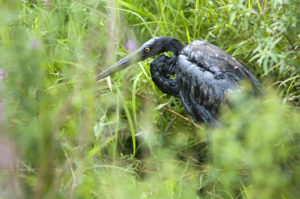We have much more to do and your continued support is needed now more than ever.
Summer Disaster Movie? No Thanks. NWF Fighting to Protect Great Lakes from Oil Pipeline Disaster
Imagine 90 percent of the surface freshwater in the United States in one place. Imagine much of that water flowing back and forth through a narrow channel, at a volume ten times the volume of water flowing over Niagara Falls.
Now imagine a pipeline carrying 23 million gallons of oil a day lying on the bottom of that channel. Imagine the pipeline is 62 years old and operated by the same company responsible five years ago for the largest inland oil spill in U.S. history.
Unfortunately, we don’t have to imagine it. It’s real. And it’s documented most recently in an excellent new video by Spencer Chumbley:
Action to Help Wildlife
The Great Lakes hold 90 percent of the nation’s surface fresh water. The Lakes’ main choke point is the Straits of Mackinac, between Lakes Michigan and Huron. Water flows through the Straits at volumes equivalent to ten Niagara Falls. And lying on the bottom of the Straits are two pipelines that carry 23 million gallons of oil a day— pipelines owned and operated by Enbridge Energy, the same company responsible in 2010 for the oil disaster in Marshall, Mich., that released more than 840,000 gallons of oil into the Kalamazoo River—contaminating 38 miles of the river.
As Grist points out, Chumbley’s video is almost like a scary movie blockbuster where a monster jumps out at us unexpectedly. However, unlike a horror flick, we’ve known for some time now that disaster can strike, and we’re doing something about it.
In a ground-breaking report, NWF shed light on the threat posed by the Enbridge oil pipeline in the Straits of Mackinac. The following year, in 2013, we commissioned a dive team to go down and videotape the pipeline. It was the first time that footage of that pipeline had been made public and showed places where the line was suspended above the floor of the lake, vulnerable to currents and stress. It also showed debris and plant growth on the pipeline.
Finally, in 2014, NWF commissioned a study by the University of Michigan’s Water Center. The Center’s David Schwab, an expert on water currents in the Great Lakes, produced a video showing what would happen if there was an oil spill in the Straits. He concluded, “This would be the worst place in the Great Lakes for an oil spill” because of the massive, fluctuating flows through the Straits.

They’re right. Shoreline areas most likely to be impacted by an oil spill are Mackinac Island, Bois Blanc Island, and the Lake Huron shoreline from Mackinac City to Rogers City. This area stretches across three counties and includes the habitat critical to the survival of endangered species such as the Piping Plover, dwarf lake iris, Houghton’s goldenrod, Michigan monkey-flower, and Pitcher’s thistle. Communities in the region would be devastated, with no more swimming, fishing, or playing in parts of the lakes for years to come.
The recommendations laid out in the State of Michigan report would lay the building blocks for rerouting the pipeline away from the Straits of Mackinac. Now it’s time for the state to implement the recommendations. Both the Attorney General Bill Schuette and DEQ Director Dan Wyant have told me that this is a high priority for them and the state and we should expect to see action soon. This is imperative. NWF is willing to help in any way possible – but ultimately, the state is the one with the authority to act on the report’s recommendations.
Federal Action Needed
There are other things we can do, and we’ve begun them. The federal government bears responsibility for pipeline safety, and it has failed dismally across the country. We can’t stand idly by while we wait for the government to act. So NWF has filed a Notice of Intent to Sue the Department of Transportation for its failure both to set safe standards for cleanup plans for pipelines that cross inland rivers and lakes, like Line 5, and to require companies like Enbridge to follow those plans.
How does this help the Straits? Well, the Department of Transportation’s failure means that Enbridge doesn’t have an approved and mandated cleanup plan for a spill – and given the scale and complexity of a major spill in the Straits, it’s hard to imagine a reasonable, responsible plan for spill response.
This all means that Enbridge right now is operating Line 5 in violation of federal law – more evidence this pipeline needs to be rerouted.
How can you help the Straits? Please ask your representatives in Congress to demand that the Department of Transportation carry out its existing legal responsibility to require oil spill response plans for pipelines that cross inland rivers and lakes.
We’re going to get this done. We’re going to get that pipeline rerouted so the Great Lakes won’t become the set of the next big disaster flick. This is no movie – this is the health of Great Lakes, and it doesn’t get any more real than that.




















